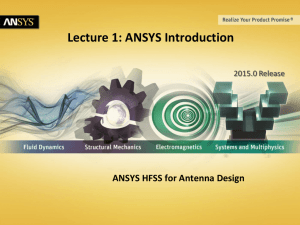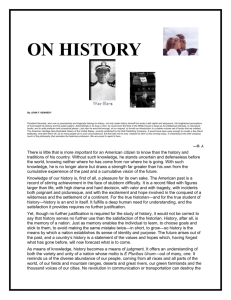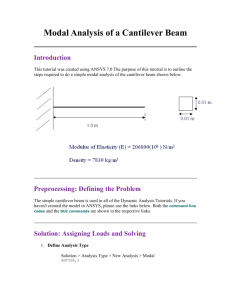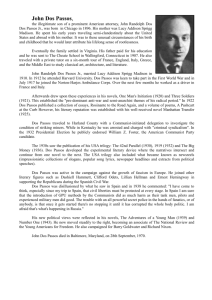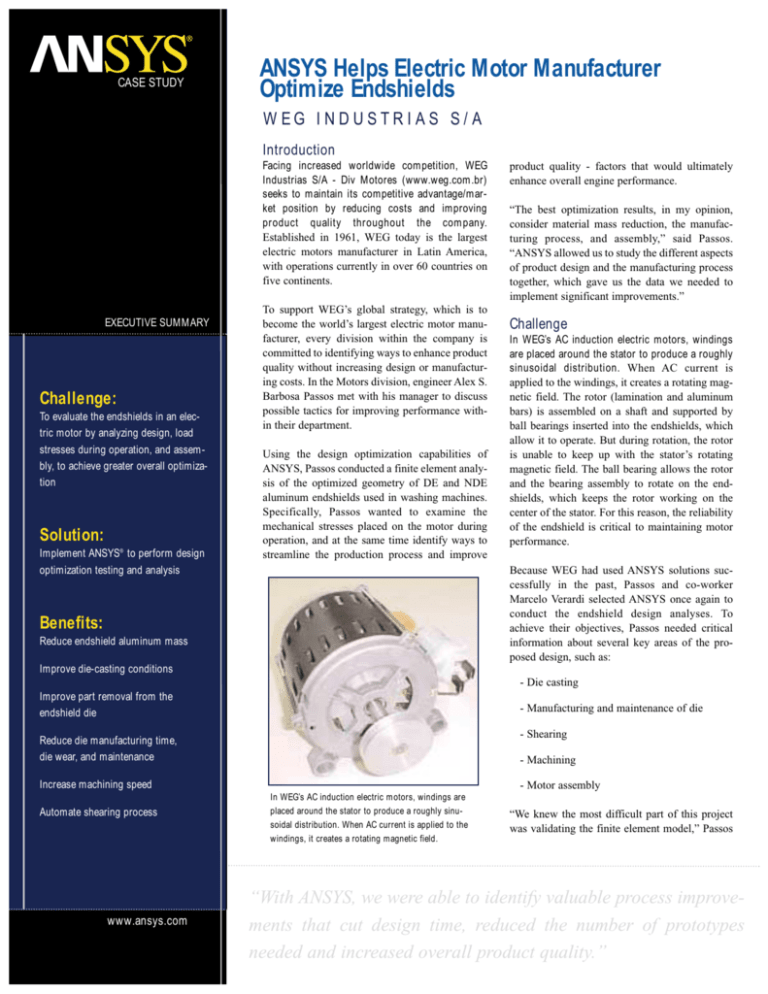
CASE STUDY
ANSYS Helps Electric Motor Manufacturer
Optimize Endshields
WEG INDUSTRIAS S/A
Introduction
Facing increased worldwide competition, WEG
Industrias S/A - Div Motores (www.weg.com.br)
seeks to maintain its competitive advantage/market position by reducing costs and improving
product quality throughout the company.
Established in 1961, WEG today is the largest
electric motors manufacturer in Latin America,
with operations currently in over 60 countries on
five continents.
EXECUTIVE SUMMARY
Challenge:
To evaluate the endshields in an electric motor by analyzing design, load
stresses during operation, and assembly, to achieve greater overall optimization
Solution:
Implement ANSYS® to perform design
optimization testing and analysis
To support WEG’s global strategy, which is to
become the world’s largest electric motor manufacturer, every division within the company is
committed to identifying ways to enhance product
quality without increasing design or manufacturing costs. In the Motors division, engineer Alex S.
Barbosa Passos met with his manager to discuss
possible tactics for improving performance within their department.
Using the design optimization capabilities of
ANSYS, Passos conducted a finite element analysis of the optimized geometry of DE and NDE
aluminum endshields used in washing machines.
Specifically, Passos wanted to examine the
mechanical stresses placed on the motor during
operation, and at the same time identify ways to
streamline the production process and improve
product quality - factors that would ultimately
enhance overall engine performance.
“The best optimization results, in my opinion,
consider material mass reduction, the manufacturing process, and assembly,” said Passos.
“ANSYS allowed us to study the different aspects
of product design and the manufacturing process
together, which gave us the data we needed to
implement significant improvements.”
Challenge
In WEG’s AC induction electric motors, windings
are placed around the stator to produce a roughly
sinusoidal distribution. When AC current is
applied to the windings, it creates a rotating magnetic field. The rotor (lamination and aluminum
bars) is assembled on a shaft and supported by
ball bearings inserted into the endshields, which
allow it to operate. But during rotation, the rotor
is unable to keep up with the stator’s rotating
magnetic field. The ball bearing allows the rotor
and the bearing assembly to rotate on the endshields, which keeps the rotor working on the
center of the stator. For this reason, the reliability
of the endshield is critical to maintaining motor
performance.
Because WEG had used ANSYS solutions successfully in the past, Passos and co-worker
Marcelo Verardi selected ANSYS once again to
conduct the endshield design analyses. To
achieve their objectives, Passos needed critical
information about several key areas of the proposed design, such as:
Benefits:
Reduce endshield aluminum mass
Improve die-casting conditions
- Die casting
Improve part removal from the
endshield die
- Manufacturing and maintenance of die
- Shearing
Reduce die manufacturing time,
die wear, and maintenance
- Machining
Increase machining speed
Automate shearing process
www.ansys.com
- Motor assembly
In WEG’s AC induction electric motors, windings are
placed around the stator to produce a roughly sinusoidal distribution. When AC current is applied to the
windings, it creates a rotating magnetic field.
“We knew the most difficult part of this project
was validating the finite element model,” Passos
“With ANSYS, we were able to identify valuable process improvements that cut design time, reduced the number of prototypes
needed and increased overall product quality.”
CASE STUDY
“Results like this provide the momentum we need to achieve our
corporate objectives and stay ahead of the competition.”
said. “The reliability of the numerical results
depends on the accuracy of the model, which
requires precise software input data as well as
information about application and machining
forces.” Because of its complexity, the project
involved several steps to ensure that product
and process requirements were addressed.
“We felt that if the amount of deformation
occurring during machining could be kept the
same along the whole cutting perimeter, there
would be no ovalization problem,” Passos said,
“only a dimensional tolerance problem that
could be easily eliminated. The smaller the
Benefits
Using ANSYS, Passos was able to validate a new
endshield design model that provides WEG
with significant benefits in process optimization, manufacturing and maintenance,
machining, and shearing. Specifically, the
aluminum mass in the DE and NDE-endshield
has been reduced by 18% and 27%, respectively. The die-casting system has been improved
because the new design eliminates sharp edges
and small concordance radii. Additionally, the
extraction angle has been increased to 6.5
degrees, which has made removing the part
from the die easier.
Solution
A geometry model generated by SolidWorks
CAD was transported to the ANSYS software
to perform the design simulation/calculations.
Passos conducted the analyses using an Intel
Pentium III 850 Mhz dual processor, 1GB of
memory, 40GB MD SCSI, and a Microsoft
Windows NT 4.0 workstation. Comparisons of
the actual and proposed designs yielded significant findings.
Calculations using fluid flow equations showed
that while both designs had the same hydraulic
diameters, the proposed design had a smaller
area from its thinner walls, meaning the amount
of aluminum needed to manufacture each endshield could be reduced. “Results from our
analysis of the die casting indicated that the new
design allowed us to reduce overall aluminum
mass in the DE and NDE-endshield by 18% and
27%, respectively,” said Passos.
Since the proposed design matches the milling
cutter diameter to the distance between the
chuck fastening and cutting edge of a spherical
finish-milling cutter, the die manufacturing can
start and finish on the same machine tool.
By incorporating adequate closed planes, the
optimized geometry of the proposed design supports automated manufacturing. “Since endshield burrs and risers are now located on predetermined planes,” Passos explained. “The
deburring process can be automated for faster
production.”
Because the proposed design changes the fastening positions and machining forces on the
endshield, the cylindricity error (ovalization)
occurring in the machining process is reduced.
www.ansys.com
As a final step to validate the proposed design,
Passos created a prototype to not only evaluate
the machining and assembly processes, and
motor performance, but also confirm the reliability of the ANSYS calculations.
Using the design optimization capabilities of ANSYS, WEG
conducted a finite element analysis of the optimized geometry of DE and NDE aluminum endshields used in washing
machines.
Die manufacturing time and maintenance have
been reduced because the concordance radii
have been custom-fit to the internal die radius,
allowing the same machine tool to perform
deburring and finishing. Die wear has also been
reduced and maintenance checks are needed
less often. Since the new design allows the endshield die to close in suitable planes, automated
shearing in a robotic cell is now possible.
bearing hub cylindricity error, the smaller the
compression force that ovalizes the external
bearing cap, which reduces the noise level and
bearing wear, and ultimately increases the bearing’s useful life.”
Because the new design does not require an
intermittent cut, one unique polycristaline diamond-cutting tool can be used which expedites
the machining process and increases overall
productivity. In addition, this tool lasts longer
than the previous hard metal tool and produces
a better surface finishing of the endshield.
To ensure the proposed design does not impact
the assembly process, Passos used ANSYS to
determine where the highest stress occurs during assembly. By isolating the area where force
is applied, Passos found that the distortion in
the contact area between the endshield and the
bolt head does not affect motor performance
since acting stresses are lower than the flow
stresses of the actual material.
“With ANSYS, we were able to identify valuable process improvements that cut design time,
reduced the number of prototypes needed and
increased overall product quality,” said Passos.
“Results like this provide the momentum we
need to achieve our corporate objectives and
stay ahead of the competition.”
Southpointe
275 Technology Drive
Canonsburg, PA 15317
U.S.A.
Toll-Free:
1.866.ANSYS.AI
Toll-Free Mexico:
001.866.ANSYS.AI
ANSYS is registered in the U.S. Patent and Trademark
Office. ©2002 SAS IP, Inc., a wholly-owned subsidiary
of ANSYS, Inc. All Rights Reserved.
MCS0099AUG02
ansysinfo@ansys.com


